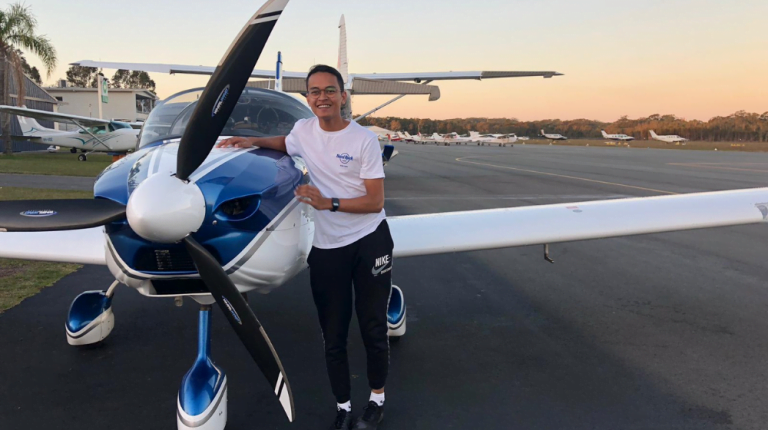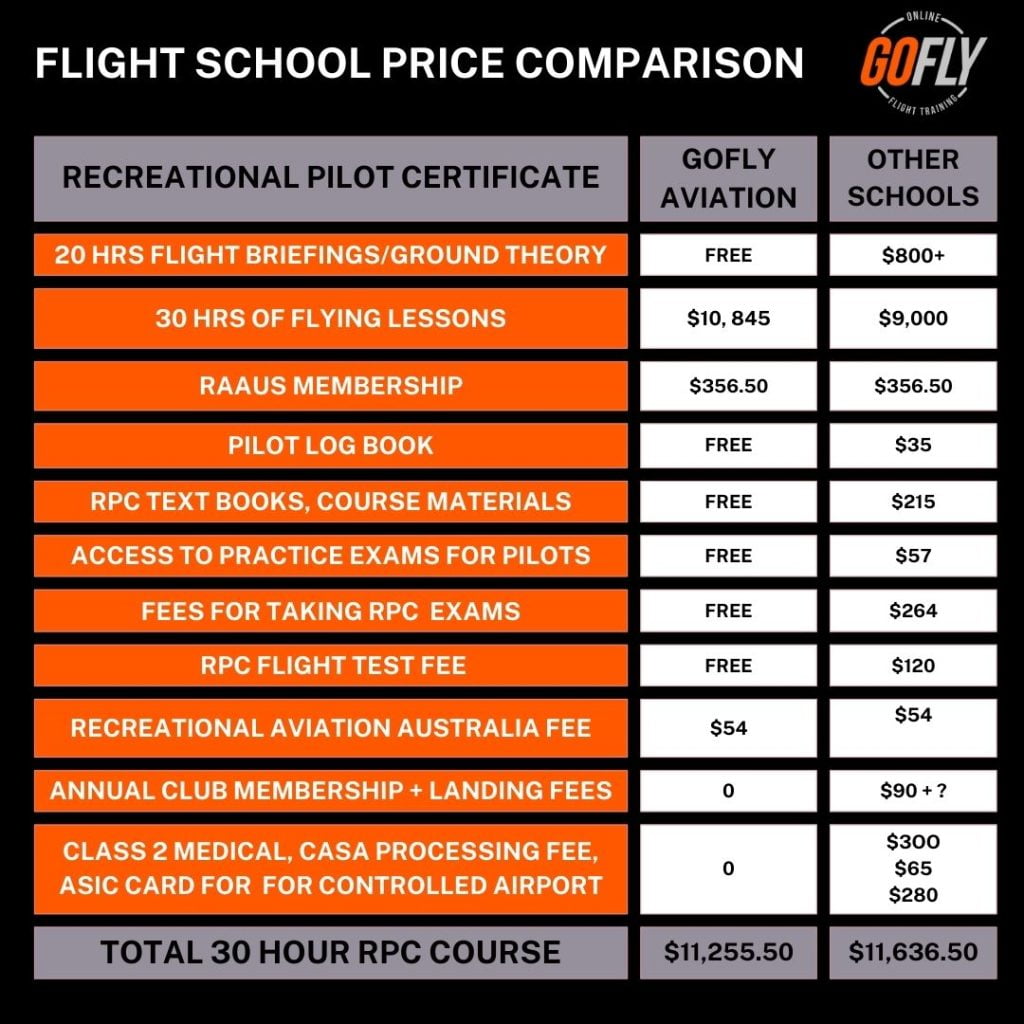1 How to compare apples with apples
It is no surprise that the second most visited page on the GoFly website is the ‘fleet and pricing’ page.
Price is important for most customers however the issue with pricing is that most flight schools do not disclose their full costs. For instance many flying schools show the hourly rate and briefing rate but not advise that there are landing charges. Most customers only look at the hourly flying rate but when you add on all the other items such as briefings and landing charges, this can increase each lesson costs by around 30 percent.
The other very important thing to ask the school is if they are quoting course costs based on the legal minimum hours to get your licence. For instance, we know of other flight schools who often quote their Recreational Pilot Certificate course at around $8,000. This quote is based on the student getting their licence in the minimum 20 hours required. The issue with this is that it sets up a false expectation because very few pilots get their licence in the minimum legal amount of time – and if they do I would be questioning the quality of their training. If the flight school is honest and playing fair they should be listing an average price for their course based on an average student or giving an expected price range. For instance, a good way of advertising this would be to say ‘Our Recreational Pilot Certificate takes 20 to 25 hours of flight training and costs between $5,980 to $7475, depending on individual competency’.
Ask the flight school ‘What is the cost per hour for your flying lessons including briefings?’ Then ask ‘How long is the average time a student takes to complete their training?’. You can then simply do the maths yourself and work out a rough realistic price. If the flight school can’t give you an answer or deflects the questions, I suggest you look for another flying school.
Another warning sign is if the flight school asks you to pay for the whole course upfront. You should be able to pay as you go.
2 Quality is more important than price
A cheaply-priced flight school does not always mean it is the best choice for you. It is the quality of pilot training that is important. Obviously price is important, but if a cheaper flight school offers lower quality training you may have saved some money but is it worth the risk of not being the best pilot you can be? The biggest issue when you’re still researching a flight school is how to determine quality. Obviously every owner of every flight school thinks they offer the best quality of instruction, so taking the owner’s word for it is not the most reliable way of determining this.
The best way to determine quality is to do some simple research. Firstly, I believe that quality flows through everything a business does. For starters, what is the flight school’s website like? Has it had a lot of thought and energy and effort put into making it easy to navigate for the user? Or is the website just a big sales ad telling you how good the flight school is and how cheap their prices are? Is there valuable information on the website to streamline your decision making? Does the website show the facilities and aircraft and do they look well cared for? Does the website have a large focus on the customer and staff? Read the testimonials but remember that they will only put positive ones on the website.
Go to their Facebook and Instagram pages and look for reviews. Type the flight school name in the Google search window and look at all the reviews on Google. This is a good way to see both positive and negative reviews, to help you make your decision. Join some Pilot forums on Facebook or elsewhere and ask other students, pilots and graduates which schools they recommend in your area.
3 Sausage factory or personalised service?
There is no doubt that all flying schools are different. The most important question initially for yourself is whether you are wanting to fly for fun or for a career? Many of the bigger flight schools can afford better simulators, more expensive and newer aircraft and better facilities. I believe there is a cut-off point though, where some of the larger schools stop offering personalised service in favour of profit-making volume. Ask yourself, do I want to learn at a large corporate school that pushes through hundreds of commercial pilots a year, or a smaller school that is more flexible? If you want to fly just for fun then maybe a larger corporate school is not for you. Remember bigger is not always better. Within the industry, the larger schools that offer VET fee and train hundreds of overseas students are commonly known as sausage factories. They are designed to do a job and that job is to churn out as many Commercial pilots as possible to satisfy their overseas contracts or VET-fee obligations.
There is nothing wrong with this but do not expect individual attention or for them to remember your name. Likewise, some flying schools may be too small for you. They may only have one aircraft and one instructor. If you want variety of aircraft and flying instructors and more flexibility, this small school may not be the best. Work out what type of aviation school you want to fly with and this will help reduce your search criteria when choosing a flight school.
4 Sometimes two flight schools are better than one
One of the biggest myths that flight schools try to promulgate is that you must complete ALL of your flight training with them. What if you find a great recreational school that you love flying at but you’re not sure of their Commercial Pilot Licence program? Or what if you have just finished your flight training at your flight school and now want to do a tailwheel conversion or Aerobatics endorsement and the school you learnt at does not offer it?
The good news is that your flight hours and experience are transferable to any pilot training school.
It also doesn’t matter whether you start off flying a Recreational Aircraft or a General Aviation aircraft as they all count towards your CPL licence if you wish to continue. For instance, I started my training with the Australian Air League in Sydney in a small Cessna 152 many years ago. The flight school was run by volunteer instructors and the quality of training was fantastic but they only trained up to PPL level. I learnt to fly there up to PPL then finished my CPL training at a school in QLD. By doing it this way I saved myself around $15,000 in flight training and got to experience two great flight schools.
So if you are very happy with a school that can conduct your initial training but can’t fulfill your advance training (such as multi-engine rating) don’t let it preclude you from starting your training with that school.
5. Visit their facilities and meet one of their instructors
This one is a must. There are two ways to do this. Firstly, you can ask the flight school if you can visit the school and talk to an instructor and see the aircraft. Do not feel bad about asking for this. Any quality flying academy or school would be more than happy to spend 20 minutes talking to you and showing you around their facilities. Make sure you book in a time and stick to that time. If the school will not talk to you unless you book a flight with them, then choose another school. Secondly, you can take a Trial Introductory Flight. All schools offers them and they allow you to see if you actually like flying and to observe the quality of instruction and instructors before you commit. It is a real flight lesson and will count towards your first certificate.
If the flight school only offers meetings with a receptionist and not a flight instructor, then once again, I suggest you choose another school that will. When you meet the instructor you can then get a feel for how much they care for you as a future student and how professional and friendly they are. You can also observe the condition of the facilities and the condition of the aircraft. If the facilities are worn, old and run down this could be a sign that the owner does not care or the business is not doing too well. The same goes for the aircraft. While most flight schools won’t have brand new aircraft, do take a look at what condition are they in. Are they fairly clean? Does it appear the staff and business care about the condition of the aircraft. The impression you get from your first visit will help you decide on whether to start training with that school. You might also like to ask to see the syllabus or whether it is online for you to view. And if you intend finishing your next level of training at another school, you might like to ask where they will keep your flight records, so that you know this school will be able to send them to the next school in a timely manner. You might like to see the room where their briefings are done and ask questions about which textbooks they use at their school.
And finally, ask them what I call the Kamikaze question, as you leave: ‘Why should I choose your flight school over all the other nearby flight schools?’ Their response may surprise or shock you, or it may be exactly what you want to hear and it will definitely help you decide.
All the best with your future flight training!
Damien Wills
CEO GoFly Group
Click on this link to see our RPC, RPL, PPL, CPL syllabus and licence prices.
Click on this link to read further aviation blogs by Damien.


